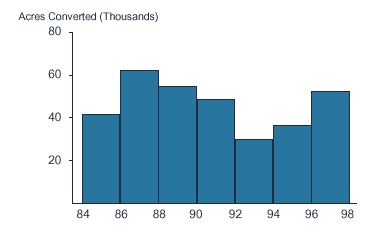Legislative Analyst's Office, December 2000

California's Economy and
Budget in Perspective |
2000 Cal Facts
Program Trends
Part 4
|
California's Crime Rate Is at a 35-Year Low
Rate Per 100,000 Population

- The crime rate reached its peak in 1980, declined for several years, increased slightly in the late 1980s, and has declined significantly each year since 1991.
The 1999 California Crime Index (CCI) is now roughly equivalent to the rate in 1964.
- No one knows for sure why crime has declined so dramatically in recent years. Most researchers believe that there are many reasons, including the aging of
the population (particularly the aging of "baby-boomers"), the decline in the use of certain drugs (particularly "crack" cocaine), incapacitation and deterrent
effects of recently enacted criminal penalties, improved economy (and thus, more jobs), better policing techniques (such as "community-oriented" policing),
and relatively peaceful gang situations in some urban areas.
Prison Inmate Population Growth Has Slowed
Annual Increase in the Population

- Although California's prison inmate population has increased substantially over the past 17 years and is expected to continue to grow, the growth has
slowed in recent years.
- The prison population increased from about 37,000 inmates in 1983 to about 162,000 in 2000. We project that the population will grow to about 177,000
by 2006.
- The growth in the prison population has largely been attributable to changes in law that increased the length of prison sentences. The recent slowdown in the
growth is probably primarily due to the decrease in crime in California. The decline in 2002 and the relative small increases are also due to the voters
approval of Proposition 36 in the November 2000 election, which will redirect some drug offenders into treatment rather than prison.
Juvenile Arrests Decline as
Youth Population Increases

- California's juvenile population (ages 10 to 17) has increased about 22 percent over the past ten years. Over the same period, however, the number of felony
juvenile arrests actually declined by about 6 percent.
- The number of felony juvenile arrests peaked in 1991 and has declined by about 19 percent since that time.
- The decline in juvenile arrests in California reflects a nationwide trend. The reasons probably include the improved economy (and thus more job
opportunities for young people), the decline in the use of certain drugs, and the relatively peaceful gang situation in urban areas.
- Historically, juveniles have had a higher arrest rate than adults. In recent years, however, the rates for juveniles and adults have become about equal.
California's Crime Rate Is Lower
Than Most Large States
1999 Rates Per 100,000 Population

- Using measures of crime employed by the federal government, California's 1999 crime rate is about 14 percent below the rate for the rest of the nation and is
the fourth lowest among the 10 largest states.
- Florida's 1999 rate was the highest among the large states and was about 63 percent higher than California's rate.
- As in California, the national crime rate and the rates of the ten largest states have declined substantially in recent years.
Crime Rates Vary Widely Among Large Counties
1998 Rates Per 100,000 Population

- Among the counties with populations of 500,000 or more, Sacramento had the highest crime rate in 1998--about 42 percent higher than the statewide rate.
San Mateo's rate was the lowest and was about half the statewide rate.
- Variations among county crime rates are probably explained by factors such as demography (areas with larger populations of young men tend to have higher
crime rates), wealth (and thus, availability of jobs and crime-fighting resources), degree of urbanization, and location of certain factors associated with crime
(such as gangs and drug manufacturers and sellers).
Environment Is Biggest Water User
(In Million Acre-Feeta)

- The Department of Water Resources (DWR) projects that the greatest demand for water in 2020 will, as today, be for environmental uses (such as wetland
habitats, fisheries, and dedicated wild and scenic rivers). However, most of the growth in demand between 1995 and 2020 will come from the urban sector.
- Assuming nondrought water conditions, DWR projects that there will be a water shortfall in 2020 of 2.9 million acre-feet absent further actions to increase
water supplies and/or reduce demand.
State Failing Ozone Standard,
But Air Quality Is Improving

- Most of the state did not attain the state's air quality standard for ozone (a key component of smog) in 1999. Ozone levels vary regionally, with the highest
concentrations in the San Joaquin Valley and the South Coast air basins.
- However, ozone concentrations have decreased substantially in most air basins since 1979, reflecting increasingly stringent air pollution controls.
Threatened/Endangered Species Concentrated in Developed Areas

- Plant and animal species can be listed as threatened or endangered under the federal and state endangered species acts. The laws prohibit the "take" or
harming of listed species. The "incidental take"--unintentional harming--of species may be permitted under certain requirements.
- In 2000, a total of 335 species are listed. While listed species occur throughout the state, they are most concentrated in the Sacramento River, San Francisco
Bay Area, and the coastal and interior areas of Southern California.
Development Takes 46,000 Acres of Agricultural Land Every Two Years. . .

But, Results in Annual Loss of Less Than 1 Percent of Agricultural Land

- Although agricultural land lost to development is relatively small on a statewide basis, these acres are often concentrated in certain regions of the state.
Timber Harvesting in State Reduced Significantly

- There are 17�million acres of commercial forestland in the state, 45�percent privately owned and 55�percent public-owned.
- From 1990-1999, timber harvesting (logging) has decreased almost 50�percent in California. The decrease is due in large part to a reduction in harvesting on
federally owned lands which declined by about 80�percent since 1990.
- Timber harvesting on private lands declined by about 27�percent between 1990 and 1994. Since then, the volume of harvesting has remained relatively
constant.
- California's forests yielded on average about $900�million worth of timber annually over the last ten years.
Return to 2000 Cal Facts Table of Contents
Continue to 2000 Cal Facts Program Trends Part 5
Return to LAO Home Page












